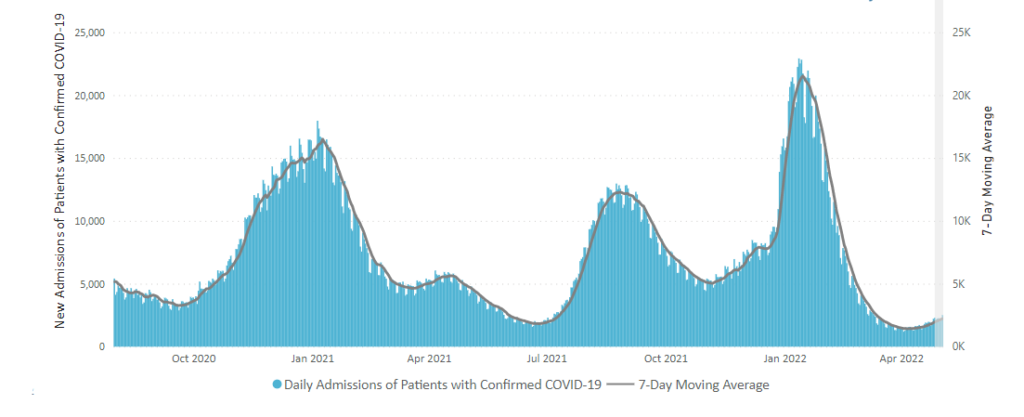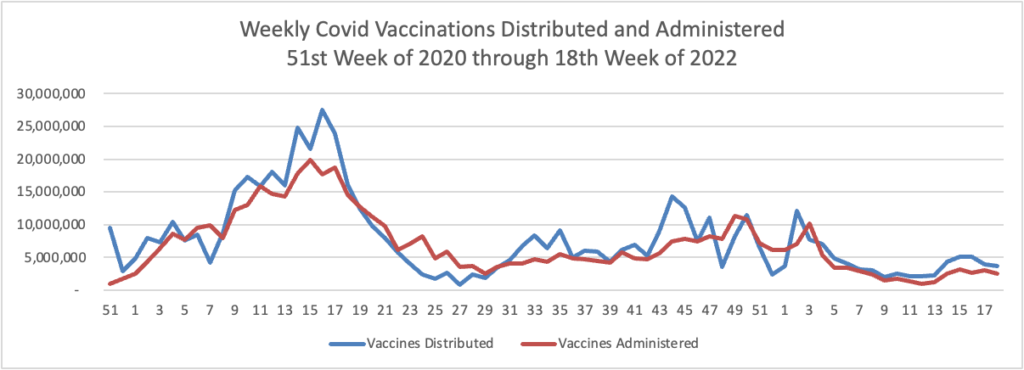Based on the CDC’s Covid Data Tracker and using Thursday as the first day of the week, here’s the FEHBlog’s weekly chart of new Covid cases displayed from the 27th week of 2021 through the 18th week of 2022.

The CDC reports in its latest weekly review that “The current 7-day daily average of new Covid hospital admissions for April 27–May 3, 2022, was 2,219. This is a 16.6% increase from the prior 7-day average (1,903) from April 20–26, 2022.

Here’s the FEHBlog’s latest weekly chart of new Covid deaths display from the 27th week of 2021 through the 18th week of 2022.

The CDC’s weekly review sums it up as follows:
COVID-19 cases and hospitalizations are on the rise in the United States. Although deaths continue to decrease, the United States is expected to reach 1 million deaths soon. * * *
As of May 5, 2022, there are 78 (2.42%) counties, districts, or territories with a high COVID-19 Community Level, 316 (9.81%) counties with a medium Community Level, and 2,826 (87.76%) counties with a low Community Level. This represents a slight (0.75 percentage points) increase in the number of high-level counties, a small (+1.86 percentage points) increase in the number of medium-level counties, and a corresponding (−2.61 percentage points) decrease in the number of low-level counties. Sixteen (28.57%) of 56 jurisdictions had no high- or medium-level counties this week.
To check your COVID-19 community level, visit COVID Data Tracker.
Here’s the FEHBlog’s weekly chart of Covid vaccinations distributed and administered from the inception of the vaccination program until this 18th week of 2021.

Nearly 75% of the U.S. population aged 12 and older are fully vaccinated and nearly 50% of the U.S. population aged 18 and older have received a booster.
STAT News reports
The White House could run out of Covid-19 vaccines if it moves forward with plans to encourage all adults to get a second Covid-19 vaccine booster dose by roughly Sept. 1, according to a tranche of budget documents sent to Congress that have not previously been made public.
In other CDC news, the American Hospital Association informs us
The Centers for Disease Control and Prevention is investigating 109 potential hepatitis cases of unknown cause in U.S. children since last October, including five deaths. More than 90% of the patients were hospitalized, 14% received liver transplants and more than half had a confirmed adenovirus infection, but officials still don’t know the actual cause of their hepatitis and cautioned that it may take time to assess the evidence and learn more. CDC alerted clinicians to the first cases last month.
To date, 25 states and territories have reported potential cases: Alabama, Arizona, California, Colorado, Delaware, Florida, Georgia, Idaho, Illinois, Indiana, Louisiana, Michigan, Minnesota, Missouri, North Carolina, North Dakota, Nebraska, New York, Ohio, Pennsylvania, Puerto Rico, Tennessee, Texas, Washington and Wisconsin.
Potential cases also have been reported in the United Kingdom and other countries
From the Rx coverage front, Medscape tells us
The US Food and Drug Administration (FDA) has cleared the first in vitro diagnostic to aid in the early detection of Alzheimer’s disease (AD).
The Lumipulse G β-Amyloid Ratio 1-42/1-40 (Fujirebio Diagnostics) test detects amyloid plaques associated with AD in adults age 55 or older who are under investigation for AD and other causes of cognitive decline.
“The availability of an in vitro diagnostic test that can potentially eliminate the need for time-consuming and expensive [positron emission tomography (PET)] scans is great news for individuals and families concerned with the possibility of an Alzheimer’s disease diagnosis,” Jeff Shuren, MD, JD, director of the FDA’s Center for Devices and Radiological Health, said in a statement.
“With the Lumipulse test, there is a new option that can typically be completed the same day and can give doctors the same information regarding brain amyloid status, without the radiation risk, to help determine if a patient’s cognitive impairment is due to Alzheimer’s disease,” he added.
From the healthcare business front, Beckers Payer Issues informs us
Cigna reported over $44 billion in total revenues in the first quarter, with the strongest growth in the company’s Evernorth business. Projected revenues at year end stand at $177 billion, according to the company’s earnings report released May 6.
“We’ve had a strong start to the year as we advance our growth strategy and support the health and well-being of our clients and customers,” Chair and CEO David Cordani said. “We’re taking decisive steps forward with innovation, new partnerships and re-investing in our company so we can achieve greater impact for the customers and communities we’re privileged to serve.”
Also, Becker’s Hospital CFO Report tells us
Driven mainly by nonoperating losses, Oakland, Calif.-based Kaiser Permanente recorded a net loss of $961 million in the first quarter of 2022, down from a net income of $2 billion in the same quarter in 2021, according to financial data released May 6.
For the quarter ending March 31, Kaiser reported total operating revenue of $24.2 billion, up from $23.2 billion the year prior. Tom Meier, corporate treasurer of Kaiser Permanente, said the revenue increase was attributed to several factors, including growth of its health plan.
Kaiser also saw its expenses increase significantly in the first quarter of 2022 to $24.3 billion, up 9.5 percent from the same quarter last year. Mr. Meier said the health system incurred about $1.4 billion in costs from COVID-19, including $900 million for the cost of care, $550 million for testing and $50 million for vaccinations.
In related news, Govexec reports
USPS saw a net loss of $639 million in the period between Jan. 1 and March 31, up from $82 million in the same period last year. The Postal Service Reform Act was not enshrined into law until after the second quarter of fiscal 2022, meaning the relief it will provide by eliminating the requirement that the Postal Service prefund health care costs for future retirees was not reflected in the financial results. USPS grew revenue in the quarter by about $900 million, a 5% increase from the same period in 2021. Volume grew by about 3%.
Federal News Network adds
Postmaster General Louis DeJoy expects the Postal Service will need to keep raising prices on its monopoly mail products for the foreseeable future, as part of a 10-year reform plan to improve its long-term financial health.
DeJoy said Thursday said the mailing industry needs to be prepared for USPS to raise prices on its market-dominant products “at an uncomfortable rate,” until it reaches a point where the agency is on track to be self-sustaining in the long term.
As we approach Mothers’ Day this weekend, the American Hospital Association tells us
The Health Resources and Services Administration will launch May 8 a toll-free hotline for expecting and new mothers experiencing mental health challenges, where trained counselors will provide brief interventions and referrals to community-based and telehealth providers as needed. Callers also will receive evidence-based information and referrals to support groups and other community resources.
“Today, we are creating a safe space for expecting and new moms who are experiencing maternal depression, anxiety or other mental health concerns to have confidential conversations and get the support they need,” said HRSA Administrator Carole Johnson. “Moms can call or text 1-833-9-HELP4MOMS and connect with a counselor at no charge. We are going to continue to grow our investments in this resource, as we know it’s what women need.”
Nothing is too good for our Moms.
